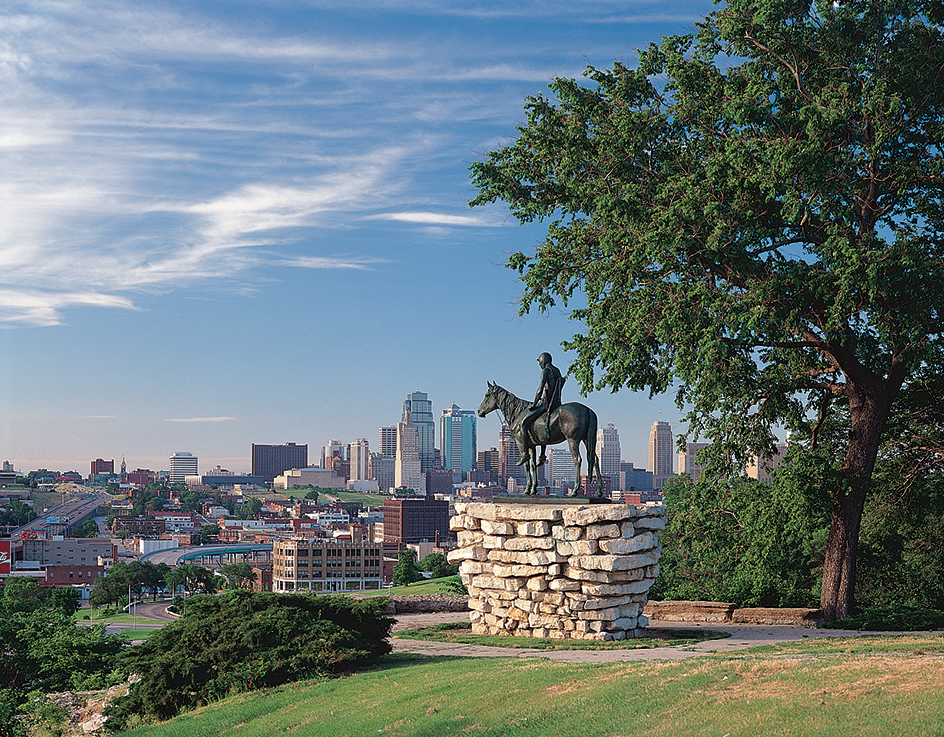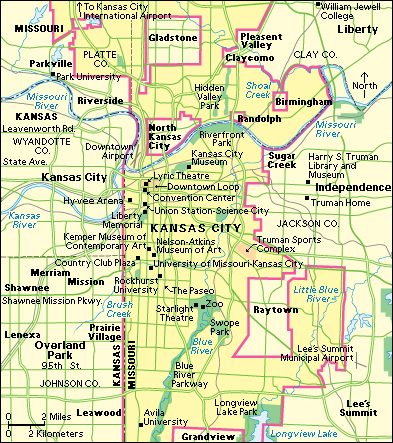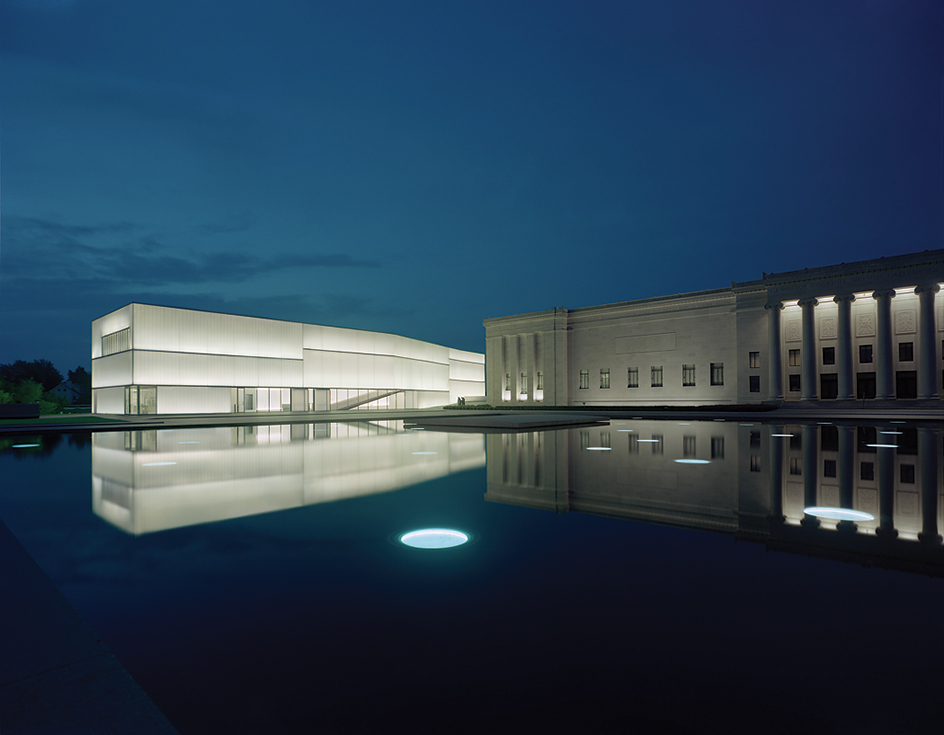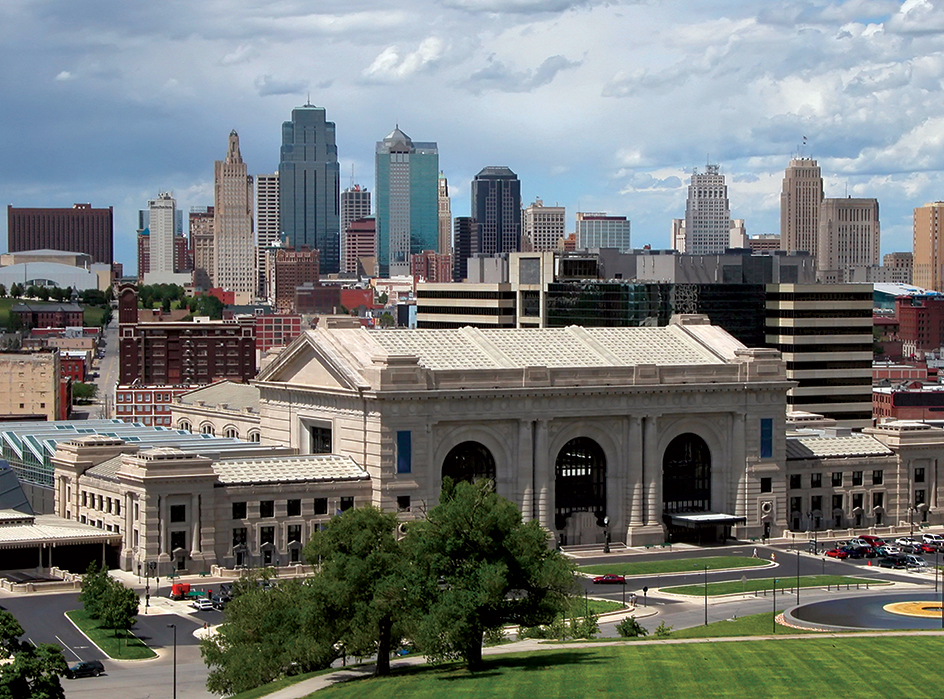Kansas City, Missouri, is the state’s largest city and a Midwestern center of commerce, industry, and transportation. It lies on the western border of Missouri, where the Kansas (or Kaw) and Missouri rivers meet. It was named for the Kansa Native American tribe, who once lived in the area. The city lies just east of Kansas City, Kansas.

In 1821, American Fur Company employees established a trading post at the site of what is now Kansas City, Missouri. They became the area’s first permanent white settlers.
The city
covers parts of Jackson, Clay, Platte, and Cass counties, north and south of the Missouri River. The oldest and most densely populated part of the city lies south of the river. North of the river, the city has more suburban features.

Kansas City’s central business district, an area called the downtown loop, is bounded on all sides by interstate highways. It lies just south of the Missouri River. Buildings in the freeway loop include City Hall, the Jackson County courthouse, the Municipal Auditorium, a convention center, and state and federal office buildings.
The Kansas City metropolitan area consists of Bates, Caldwell, Cass, Clay, Clinton, Jackson, Lafayette, Platte, and Ray counties in Missouri; and Johnson, Leavenworth, Linn, Miami, and Wyandotte counties in Kansas.
The people.
The vast majority of Kansas City’s people were born in the United States. Many people in the city are of English, German, Irish and ancestry. African Americans make up about 25 percent of the city’s population.
Economy.
Kansas City is often called the Heart of America because it lies almost in the center of the United States. This location has helped make Kansas City a distribution, telecommunications, transportation, and warehouse center.
Metropolitan Kansas City ranks as the largest winter-wheat market in the United States. It ranks high among American cities in the capacity of its grain elevators. It also has vast underground storage facilities. A system of limestone mines lies beneath the metropolitan area. Many of these mines have been converted into warehouses.
Kansas City is one of the busiest rail centers in the United States. Passenger trains and a number of major railroad freight lines serve the metropolitan area. Kansas City is also a center for trucking transportation. Several barge lines operate on the Missouri River. Kansas City International Airport is the city’s main air terminal.
Service industries are important to the economy. Federal, state, and local governments and the wholesale and retail trade employ many workers. The city is headquarters for several engineering and architecture firms.
The area has a large number of manufacturing firms. Automobile assembly, food processing, and printing and publishing rank as the largest manufacturing industries. The city is one of the nation’s leading producers of wheat flour. Other important industrial activities include the production of chemicals, clothing, electric equipment, fiber-optic communication systems, metal goods, motorcycles, and soap. Kansas City has a daily newspaper, The Kansas City Star.
Education.
Kansas City Public Schools and a number of other public school systems serve the city. In addition, thousands of students attend private and church-supported schools in the city.
Kansas City is the site of the University of Missouri-Kansas City, a branch of the state university system. Other institutions of higher learning include Avila University, the Kansas City Art Institute, Midwestern Baptist Theological Seminary, the Research College of Nursing, Rockhurst University, and St. Paul School of Theology. William Jewell College is in nearby Liberty, and Park University is in Parkville. MRIGlobal in Kansas City conducts scientific research.
The Kansas City Public Library and its branches serve the city. The Linda Hall Library is one of the country’s largest privately financed libraries of scientific and technical research materials. The Harry S. Truman Presidential Library and Museum in nearby Independence houses documents and mementos of Truman’s presidency.
Cultural life.
The Nelson-Atkins Museum of Art is known for its fine collection of Asian art. The museum also features the Donald J. Hall Sculpture Park, which includes the largest collection outside the United Kingdom of the work of the famous British sculptor Henry Moore. Nearby is the Kemper Museum of Contemporary Art. These museums are near the Country Club Plaza shopping district, which is known for its Spanish architecture and fountains.

Kansas City became famous during the 1920’s and 1930’s for its many jazz clubs, where such musicians as Count Basie and Charlie Parker began their careers. The 18th & Vine Historic District, once the site of many of the jazz clubs, is now the home of the American Jazz Museum. The museum shares its space with the Negro Leagues Baseball Museum. The Kansas City Museum offers exhibits and programs on area history. The Arabia Steamboat Museum features items salvaged from a sunken steamboat. The Sea Life Kansas City aquarium displays thousands of sea creatures. The science museum Science City is on the edge of the downtown area.
The Lyric Opera of Kansas City, the Kansas City Symphony, and the Kansas City Ballet perform at the Kauffman Center for the Performing Arts. The Starlight Theatre, an outdoor amphitheater, offers a summer program of musicals. The Kansas City Repertory Theatre, a professional acting company, stages a yearly program of plays.
Kansas City’s park system includes many parks. Swope Park, which occupies 1,800 acres (730 hectares), is one of the largest city parks in the United States. It includes the Kansas City Zoo, the Starlight Theatre, golf courses, and a swimming pool. Liberty Memorial, a monument to World War I (1914-1918) and world peace, stands 217 feet (66 meters) high in Penn Valley Park near downtown. Also at the Liberty Memorial is the National World War One Museum, a museum devoted to the conflict. Kansas City is called the City of Fountains for its many public and private fountains.
The city is the home of the Kansas City Chiefs of the National Football League, the Kansas City Royals of Major League Baseball, and Sporting Kansas City of Major League Soccer. Every fall, the city hosts the American Royal. This event, held in the old stockyards and meat-packing district along the Kansas River, is one of the nation’s largest horse and livestock shows.
Government.
Kansas City has a council-manager government. The voters elect the mayor and the 12 other members of the City Council to four-year terms. The council appoints a city manager as the chief administrative official. A city income tax and a sales tax provide the largest sources of revenue.
History.
The Kansa lived at the meeting place of the Kansas and Missouri rivers before the arrival of white settlers. By the 1820’s, the Kansa and another local tribe, the Osage, had left the area as the result of treaties. During the 1830’s, Native American tribes who had been forced from their lands in the East, such as the Shawnee and the Wyandot, settled just across the border.
In 1821, Francois Chouteau and several other employees of the American Fur Company established a trading post in the area that is now Kansas City. By the late 1820’s, Chouteau had set up his headquarters at a site that became known as Chouteau’s Landing. In 1838, a group of investors purchased Chouteau’s Landing and named it the Town of Kansas. Steamboat traffic on the Missouri River increased during the 1840’s, and the Town of Kansas began to grow.
A second settlement, called Westport, was 4 miles (6.4 kilometers) south of the Town of Kansas. Westport was founded in the early 1830’s and served as a trading center for New Mexico. Overland traffic moved along the Santa Fe Trail, which cut through the town. Later, settlers using the Oregon Trail and gold seekers on their way to California traveled through Westport.
The Town of Kansas also profited from the overland trade. It served as the river port for Westport, and many people even called it Westport Landing. In 1850, the Town of Kansas received a charter from Jackson County. In 1853, it was incorporated as the City of Kansas.
The American Civil War (1861-1865) seriously damaged the economy of the area. Many people moved away after the area became the site of bitter fighting between Confederate and Union supporters. The most violent clash, the Battle of Westport, took place in 1864, when about 30,000 soldiers fought just south of Westport. By the end of the war, the profitable river and overland trade had died. Business leaders realized that the future of the City of Kansas depended on railroads. In 1869, the city opened the first railroad bridge over the Missouri River. The bridge helped make the city a link in the nation’s transcontinental railroad system. The population grew rapidly, from 3,500 in 1865 to 55,785 in 1880.
During the 1870’s and 1880’s, the city developed as a market for the grain of the surrounding farmland. It also became a stockyard center as the railroads brought cattle from the West. Meat-packing and flour-milling industries developed. In 1889, a new charter officially changed the city’s name to Kansas City. Westport became part of Kansas City in 1897, and the population reached 163,752 in 1900.
Kansas City continued to grow as a center of commerce and industry. By 1920, it had a population of 324,410. During the 1920’s, the Democratic Party machine of Thomas J. Pendergast gained control of the city government. The Pendergast machine supported many civic improvements, but corruption became common among Kansas City politicians. In 1940, a reform group won control of the city government. Harry S. Truman, a Pendergast-supported U.S. senator from nearby Independence, became Vice President in January 1945. He assumed the presidency a few months later when President Franklin D. Roosevelt died.
Kansas City’s area increased from 62 square miles (161 square kilometers) to 316 square miles (818 square kilometers) in the 1950’s and 1960’s. The city’s population reached a peak of 507,330 by 1970. It dropped during the 1970’s and 1980’s but rose during the 1990’s and the first two decades of the 2000’s. According to the 2020 census, the city had 508,090 people.
Since the 1950’s, much urban redevelopment has taken place in Kansas City. In the mid-1970’s, a convention center was built in a previously run-down section of the downtown loop. Crown Center, another major project, includes 85 acres (34 hectares) of apartment buildings, hotels, office buildings, restaurants, and shops south of the loop. In the mid-1980’s, developments in the downtown loop included new construction and the restoration of the old Quality Hill neighborhood.
In 1999, the renovation of Union Station was finished. The 1914 building at the edge of downtown became a theater and restaurant complex and the home of a science museum. The area north of the depot, known as the Freight House District, has become a popular site of art galleries and restaurants. A major flood control and beautification project improved Brush Creek, which flows through the Country Club Plaza. In 2007, the Sprint Center (now called the T-Mobile Center) opened in downtown Kansas City. The center, built with a combination of private and public funds, hosts sporting events, concerts, and other events. 
In 2010, the Kansas City school board closed nearly half the city’s public schools. The school closures allowed the district to avoid bankruptcy. Public school enrollment in the city had declined steeply since the late 1900’s.
Development downtown and in neighborhoods on the city’s southeast side increased through the 2010’s. City leaders were forced to address conflicts between development and gentrification—that is, increases in a neighborhood’s housing values and costs. Neighborhood improvements increased tax revenues but displaced thousands of longtime residents.
See also Pendergast, Thomas Joseph.
